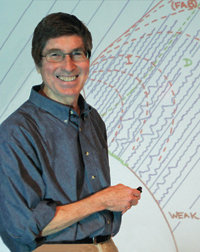Old School, New Chair
AT A SCIENTIFIC MEETING two years ago, while the 60 other space physicists clicked through their PowerPoint presentations, Marty Lee rolled out an overhead projector and plunked down hand-drawn viewgraph transparencies. His colleagues took great delight in gently poking fun and calling him a “dinosaur.”
“Only very recently was I embarrassed into getting up to date,” he says somewhat sheepishly. With a nod in the direction of an open laptop sitting on his office desk he adds, “So I bought this thing two years ago and I’m making progress, despite the fact that I never learned to type.” Dragged “kicking and screaming a little bit,” Lee is one-finger typing his way into the computer age.
“To be honest, the computer revolution kind of went by me—I think probably because I always enjoyed the analytical stuff. I love the close tie of physics to mathematical analysis,” Lee says.
It is the “tidiness” of mathematical analysis that drew Lee into the field years ago and it has kept him there, a sharpened pencil in hand, ever since.
But as the frontiers of knowledge get pushed further out—and problems become more complex—physicists increasingly rely on numerical simulations to forge ahead. For pencil-and-paper guys like Lee, this means funds for analysis-based projects are harder to secure.
Serving on a NASA review panel for a heliospheric theory and modeling competition several years ago, Lee recalls that 85 percent of the proposals were for numerical, computer-based calculations or simulations. “That’s not like it was 30 years ago, so there’s certainly been an evolution of the field.”
While he stood on the sidelines as the computer age swept the planet, Lee, too, evolved over 30 years since landing at UNH in 1979 as a young, inexperienced research scientist.
As he recounted at the late-September reception honoring his appointment as a UNH Presidential Chair, “I found a home at UNH after failing to get tenure at another institution, which at the time seemed like a death knell. But it turned out to be propitious, for that failure led me to a place where I found mentors and colleagues who provided support and the environment I needed to find my way and figure out how to become a good scientist.”
Indeed. In accepting the honor from UNH President Mark Huddleston with colleagues gathered round (including three others being honored), Lee credited his personal achievements to a much larger sphere of influence.
“I am so often impressed and humbled by my colleagues at UNH and I know the achievements of so many of them could be and should be celebrated. In recognizing individual achievements today we are actually celebrating the strength of the institution,” Lee said with characteristic modesty.
The newly created awards of Presidential Chair and Presidential Professor, Huddleston noted, represent the highest level of excellence at UNH. “The commitment of these faculty members to research, teaching, and engagement not only benefits students but enhances the reputation of the colleges and the university as a whole.”
Lee’s work in theoretical space physics, astrophysics, and plasma physics as a founding member of the Space Science Center’s Solar-Terrestrial Theory Group “has contributed to and has had ongoing influence on NASA experiments and programs for over 20 years,” Huddleston added.
As Lee noted upon receiving the honor, that he is still contributing is due entirely to the skill of students and faculty of the Department of Kinesiology who, six years ago, helped save his life after he went into cardiac arrest at the UNH Field House.
Lee’s area of expertise through the decades has been in energetic particle processes—a field he became interested in as a physics graduate student at the University of Chicago. He arrived at Chicago with a fellowship in hand, which freed him from having to take on teaching assistant duties, a love of and gift for mathematics, and no particular interest in space physics.
“I was never one of these amateur astronomy types as a kid. “I ended up in this field because one of the professors on my qualifying exam committee was in space science and he convinced me to come work with him.”
Lee’s focus has been the behavior of energetic ions throughout the heliosphere—the vast cavity “blown” into the interstellar medium by the solar wind and extending beyond the planets. He believes analytical work he did on data from the International Sun-Earth Explorer mission was probably the biggest accomplishment of his career.
ISSE was a three-satellite mission launched in 1977-78 to study the relationship between Earth and the Sun, the solar wind, and cosmic rays. (Lee’s SSC colleague Eberhard Möbius was a co-investigator on the mission.) In November 1978 there was a very big, very well observed shock wave that provided a rich data set, including the first good look at the orientation and structure of the shock wave and its associated energetic particles and magnetic waves.
“By establishing the orientation using three satellites we could look into the energetic particles in great detail, and I came up with an analytical theory that unified the waves and energetic particles.”
Lee hopes to collaborate with Möbius by analyzing data from the Interstellar Boundary Explorer mission, which was launched this past October 19 to map the edge of our solar system for the first time. Möbius is lead UNH scientist on the mission.
“Through an analytical approach, I’d like to be able to help Eberhard derive a little more scientific pleasure from the mission, not just by interpreting the data but by helping to shed more light on the physical processes that occur out in these distance reaches of the heliosphere,” Lee says.
It is this type of exploration into unknown frontiers that always generates rich new information and keeps the pencil-and-paper guys busy.
“Whenever there’s a new mission, new measurements that have not been made before, people jump on every little twist and turn in the data and all the basic, simpler things get addressed again,” Lee says.
With IBEX now poised to provide the first glimpse beyond the solar system and into the galactic frontier, Lee, pencil in hand, will be ready to have at the data.
 |
Marty Lee Photo: David Sims, UNH-EOS |
“To be honest, the computer revolution kind of went by me—I think probably because I always enjoyed the analytical stuff. I love the close tie of physics to mathematical analysis,” Lee says.
It is the “tidiness” of mathematical analysis that drew Lee into the field years ago and it has kept him there, a sharpened pencil in hand, ever since.
But as the frontiers of knowledge get pushed further out—and problems become more complex—physicists increasingly rely on numerical simulations to forge ahead. For pencil-and-paper guys like Lee, this means funds for analysis-based projects are harder to secure.
Serving on a NASA review panel for a heliospheric theory and modeling competition several years ago, Lee recalls that 85 percent of the proposals were for numerical, computer-based calculations or simulations. “That’s not like it was 30 years ago, so there’s certainly been an evolution of the field.”
While he stood on the sidelines as the computer age swept the planet, Lee, too, evolved over 30 years since landing at UNH in 1979 as a young, inexperienced research scientist.
As he recounted at the late-September reception honoring his appointment as a UNH Presidential Chair, “I found a home at UNH after failing to get tenure at another institution, which at the time seemed like a death knell. But it turned out to be propitious, for that failure led me to a place where I found mentors and colleagues who provided support and the environment I needed to find my way and figure out how to become a good scientist.”
Indeed. In accepting the honor from UNH President Mark Huddleston with colleagues gathered round (including three others being honored), Lee credited his personal achievements to a much larger sphere of influence.
“I am so often impressed and humbled by my colleagues at UNH and I know the achievements of so many of them could be and should be celebrated. In recognizing individual achievements today we are actually celebrating the strength of the institution,” Lee said with characteristic modesty.
The newly created awards of Presidential Chair and Presidential Professor, Huddleston noted, represent the highest level of excellence at UNH. “The commitment of these faculty members to research, teaching, and engagement not only benefits students but enhances the reputation of the colleges and the university as a whole.”
Lee’s work in theoretical space physics, astrophysics, and plasma physics as a founding member of the Space Science Center’s Solar-Terrestrial Theory Group “has contributed to and has had ongoing influence on NASA experiments and programs for over 20 years,” Huddleston added.
As Lee noted upon receiving the honor, that he is still contributing is due entirely to the skill of students and faculty of the Department of Kinesiology who, six years ago, helped save his life after he went into cardiac arrest at the UNH Field House.
Lee’s area of expertise through the decades has been in energetic particle processes—a field he became interested in as a physics graduate student at the University of Chicago. He arrived at Chicago with a fellowship in hand, which freed him from having to take on teaching assistant duties, a love of and gift for mathematics, and no particular interest in space physics.
“I was never one of these amateur astronomy types as a kid. “I ended up in this field because one of the professors on my qualifying exam committee was in space science and he convinced me to come work with him.”
Lee’s focus has been the behavior of energetic ions throughout the heliosphere—the vast cavity “blown” into the interstellar medium by the solar wind and extending beyond the planets. He believes analytical work he did on data from the International Sun-Earth Explorer mission was probably the biggest accomplishment of his career.
ISSE was a three-satellite mission launched in 1977-78 to study the relationship between Earth and the Sun, the solar wind, and cosmic rays. (Lee’s SSC colleague Eberhard Möbius was a co-investigator on the mission.) In November 1978 there was a very big, very well observed shock wave that provided a rich data set, including the first good look at the orientation and structure of the shock wave and its associated energetic particles and magnetic waves.
“By establishing the orientation using three satellites we could look into the energetic particles in great detail, and I came up with an analytical theory that unified the waves and energetic particles.”
Lee hopes to collaborate with Möbius by analyzing data from the Interstellar Boundary Explorer mission, which was launched this past October 19 to map the edge of our solar system for the first time. Möbius is lead UNH scientist on the mission.
“Through an analytical approach, I’d like to be able to help Eberhard derive a little more scientific pleasure from the mission, not just by interpreting the data but by helping to shed more light on the physical processes that occur out in these distance reaches of the heliosphere,” Lee says.
It is this type of exploration into unknown frontiers that always generates rich new information and keeps the pencil-and-paper guys busy.
“Whenever there’s a new mission, new measurements that have not been made before, people jump on every little twist and turn in the data and all the basic, simpler things get addressed again,” Lee says.
With IBEX now poised to provide the first glimpse beyond the solar system and into the galactic frontier, Lee, pencil in hand, will be ready to have at the data.
by David Sims, Science Writer, Institute for the Study of Earth, Oceans, and Space. Published in Fall 2008 issue of EOS .
